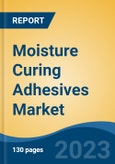Free Webex Call
The Moisture Curing Adhesives Market was valued at USD 4.85 Billion in 2024, and is expected to reach USD 7.13 Billion by 2030, rising at a CAGR of 6.84%. Moisture curing adhesives, known for their ability to bond and cure in the presence of ambient humidity, are gaining momentum across industries seeking efficient, durable, and more environmentally conscious bonding solutions. The market's expansion is fueled by increased demand in high-growth sectors such as construction, woodworking, and automotive manufacturing. These adhesives offer robust mechanical properties, long open times, and superior adhesion across various substrates, positioning them as preferred solutions for complex structural applications. With growing environmental awareness and tightening regulations, the market is also witnessing a shift toward sustainable, low-VOC formulations, further enhancing the appeal of moisture curing technologies. Speak directly to the analyst to clarify any post sales queries you may have.
10% Free customizationThis report comes with 10% free customization, enabling you to add data that meets your specific business needs.
Key Market Drivers
Increasing Demand in Construction Activities
The rising demand from the construction sector is a significant driver of the moisture curing adhesives market. These adhesives are widely used in wood-based construction applications such as flooring and paneling, thanks to their high bond strength and long-lasting performance. In 2023, countries like China, Canada, and Germany led global exports in wood building materials, underlining strong demand for engineered wood and laminated panels. The adhesives play a critical role in enhancing structural integrity and visual appeal in residential and commercial construction projects. Moreover, infrastructure initiatives in emerging economies, particularly in Asia-Pacific, are creating favorable conditions for adhesive manufacturers. Government-backed urban development and housing programs are accelerating demand for durable, moisture-resistant bonding solutions, propelling market growth.Key Market Challenges
Stringent Environmental Regulations
Stringent environmental regulations present a major challenge for manufacturers in the moisture curing adhesives market. Many formulations contain volatile organic compounds (VOCs) and other regulated substances, requiring compliance with global emission standards and safety norms. These regulatory requirements often lead to increased production costs, as companies must invest in reformulating products and modifying manufacturing processes to meet sustainability benchmarks. Additionally, securing regulatory approvals for new or modified products can delay market entry and impede innovation. To remain competitive, manufacturers are investing in R&D for low-VOC, bio-based alternatives and collaborating with regulators to develop clear compliance pathways, while maintaining the performance expectations of end users.Key Market Trends
Increasing Adoption of Sustainable Adhesives
The market is seeing a significant trend toward the adoption of sustainable moisture curing adhesives. In response to increasing environmental awareness, manufacturers are prioritizing the development of eco-friendly products that reduce environmental impact without compromising on performance. These adhesives are typically formulated with reduced VOC content and incorporate bio-based or recycled raw materials. End-use industries, especially construction and automotive, are increasingly favoring sustainable solutions to meet internal ESG goals and external regulatory pressures. This trend is expected to accelerate as companies seek to differentiate themselves through environmentally responsible product lines that align with global sustainability objectives.Key Market Players
- 3M Company
- Advatac Ltd.
- Apollo Chemicals Ltd.
- Bostik SA
- Daubert Chemical Co., Inc.
- Delo Industrial Adhesives LLC
- Dow, Inc.
- DuPont de Nemours, Inc.
- Dymax Corporation
- Franklin International, Inc.
Report Scope:
In this report, the Global Moisture Curing Adhesives Market has been segmented into the following categories, in addition to the industry trends which have also been detailed below:Moisture Curing Adhesives Market, By Chemistry:
- Polyurethane
- Silicone
- Cyanoacrylate
- Polyolefin
Moisture Curing Adhesives Market, By Application:
- Construction
- Automotive
- Wood Working
- Textile
- Others
Moisture Curing Adhesives Market, By Region:
- Asia Pacific
- China
- India
- Japan
- Australia
- South Korea
- North America
- United States
- Canada
- Mexico
- Europe
- France
- United Kingdom
- Italy
- Germany
- Spain
- South America
- Brazil
- Argentina
- Colombia
- Middle East & Africa
- South Africa
- Saudi Arabia
- UAE
Competitive Landscape
Company Profiles: Detailed analysis of the major companies present in the Global Moisture Curing Adhesives Market.Available Customizations:
With the given market data, the publisher offers customizations according to a company's specific needs. The following customization options are available for the report.Company Information
- Detailed analysis and profiling of additional market players (up to five).
This product will be delivered within 1-3 business days.
Table of Contents
1. Product Overview
2. Research Methodology
3. Executive Summary
6. Global Moisture Curing Adhesives Market Outlook
7. Asia Pacific Moisture Curing Adhesives Market Outlook
8. Europe Moisture Curing Adhesives Market Outlook
9. North America Moisture Curing Adhesives Market Outlook
10. South America Moisture Curing Adhesives Market Outlook
11. Middle East and Africa Moisture Curing Adhesives Market Outlook
12. Market Dynamics
13. Market Trends & Developments
16. Porter’s Five Forces Analysis
18. Competitive Landscape
Companies Mentioned
- 3M Company
- Advatac Ltd.
- Apollo Chemicals Ltd.
- Bostik SA
- Daubert Chemical Co., Inc.
- Delo Industrial Adhesives LLC
- Dow, Inc.
- DuPont de Nemours, Inc.
- Dymax Corporation
- Franklin International, Inc.
Table Information
| Report Attribute | Details |
|---|---|
| No. of Pages | 185 |
| Published | June 2025 |
| Forecast Period | 2024 - 2030 |
| Estimated Market Value ( USD | $ 4.85 Billion |
| Forecasted Market Value ( USD | $ 7.13 Billion |
| Compound Annual Growth Rate | 6.8% |
| Regions Covered | Global |
| No. of Companies Mentioned | 10 |









